 W
WTandanus is a genus of eeltail catfishes endemic to Australia.
 W
WKoonwarria manifrons is an extinct prehistoric ray-finned fish that lived in a polar lake in what is now Koonwarra, Victoria, Australia. Fossils have been retrieved from the Strzelecki Group.
 W
WAmbassis macleayi, commonly known as Macleay's glassfish, Macleay's glass perchlet, Macleay's perchlet, reticulated glassfish, reticulated perchlet, or network perchlet, is a species of freshwater fish in the family Ambassidae. It is native to northern Australia and the trans-Fly River region of New Guinea. It is a fish with a vertically flat, narrow body and a standard length generally between 35 and 45 mm, with large specimens reaching 77 mm (3.0 in) long. It generally eats water fleas and other small invertebrates. This fish is considered to be a least-concern species according to the International Union for Conservation of Nature (IUCN), although it could suffer from habitat degradation due to feral pigs and invasive water plants such as the water hyacinth. The fish is suitable for aquarium use in tanks containing other non-aggressive species.
 W
WAmbassis miops, commonly known as the flag-tailed glassfish, is a species of fish in the family Ambassidae. It is native to eastern Australia. It is found only in a few coastal sites along the North Queensland coast. A distinguishing feature of this species is a tiny spine is situated above the rear corner of the eye.
 W
WThe freshwater anchovy is a species of fish in the family Engraulidae. It is endemic to Australia. Often mistaken for a Minnow.
 W
WThe Australian grayling is a primarily freshwater fish found in coastal rivers in south-eastern mainland Australia and Tasmania. In past decades it has also been known as the “cucumber mullet” or “cucumber herring,” for its cucumber-like odour.
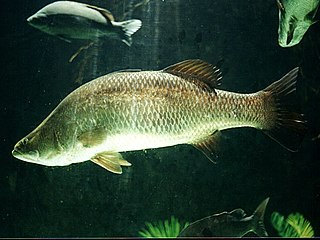 W
WThe barramundi or Asian sea bass, is a species of catadromous fish in the family Latidae of the order Perciformes. The species is widely distributed in the Indo-West Pacific region from South Asia to Papua New Guinea and Northern Australia.
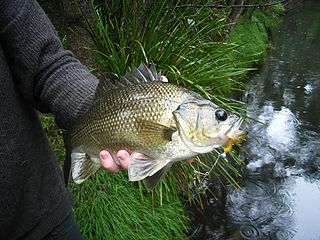 W
WThe Australian bass is a small to medium-sized, primarily freshwater species of fish found in coastal rivers and streams along the east coast of Australia. It is a member of the family Percichthyidae and the genus Macquaria. Australian bass is an important member of the native fish assemblages found in east coast river systems. It is a predatory native fish and an extremely popular angling species. The species was simply called perch in most coastal rivers where it was caught until the 1960s, when the name Australian bass started to gain popularity.
 W
WThe river blackfish is a freshwater fish endemic to the temperate waters of south-eastern Australia. It is found from southern Queensland through to central Victoria, including in the Murray-Darling river system. It is also found in some eastern and southern flowing coastal rivers. Found primarily in upland and "midland" habitats, though early records of fish fauna suggest it was originally far more extensively distributed and was found in some lowland habitats as well. Originally, river blackfish co-inhabited many of its lowland and "midland" habitats with species such as Murray cod and golden perch, and its upland habitats with species such as trout cod and Macquarie perch. It is a popular angling fish in some parts of its range.
 W
WThe two-spined blackfish is a species of temperate perch endemic to Australia.
 W
WThe Pacific blue-eye is a species of fish in the subfamily Pseudomugilinae native to eastern Australia. Described by Austrian naturalist Rudolf Kner in 1866, it comprises two subspecies that have been regarded as separate species in the past and may be once again with further study. It is a common fish of rivers and estuaries along the eastern seaboard from Cape York in north Queensland to southern New South Wales, the Burdekin Gap in central-north Queensland dividing the ranges of the two subspecies.
 W
WThe spotted blue-eye is a species of fish in the family Pseudomugilidae. It is native to Papua New Guinea and northern Australia. It adapts readily to captivity and can be kept in a small freshwater aquarium.
 W
WThe sleepy cod is a medium-sized fish in the family Butidae, native to tropical fresh waters of northern Australia and questionably from New Guinea. It is a member of the order Perciformes, thus is unrelated to the true cods in the order Gadiformes. Neither are they closely related to the Australian freshwater cods such as the Murray cod of the family Maccullochella.
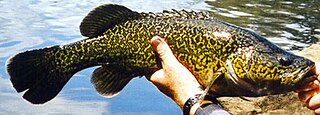 W
WThe eastern freshwater cod, also known as the eastern cod or Clarence River cod, is a large predatory freshwater fish of the genus Maccullochella and the family Percichthyidae, that occur in the coastal Clarence River system of north-eastern New South Wales. Eastern freshwater cod are closely related to the Murray cod of the Murray-Darling River system, and are considered an icon of the Clarence River system.
 W
WThe eel-tailed catfish, Tandanus tandanus, is a species of catfish of the family Plotosidae. This fish is also known as dewfish, freshwater catfish, jewfish, and tandan.
 W
WGalaxias olidus, the mountain galaxias, is a species of freshwater galaxiid fish widely found in southeastern Australia.
 W
WThe climbing galaxias or kōaro is a fish of the family Galaxiidae found in Australia, New Zealand, and nearby islands. The name climbing galaxias is used in Australia, and koaro or kōaro in New Zealand. Further vernacular names include short-finned galaxias, broad-finned galaxias, Cox's mountain galaxias, and Pieman galaxias.
 W
WAmbassis jacksoniensis, commonly known as the Port Jackson glassfish or Port Jackson perchlet, is a species of fish in the family Ambassidae native to eastern Australia. It gains its common name from its transparent appearance.
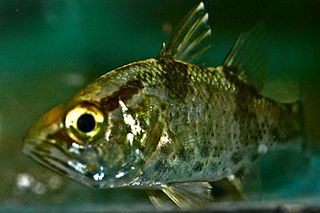 W
WGlossamia aprion is a species of freshwater ray-finned fish from the family Apogonidae, the cardinalfishes, from northern Australia and New Guinea. In Australia, it is commonly known as the mouth almighty.
 W
WThe western carp gudgeon is one of several carp gudgeon species. Carp gudgeons are very small perciform fish found in the Australian Murray-Darling River system, mainly in lowland environments, but some have been observed in upland environments. They are often found in small creeks, as well as billabongs and the edges of larger rivers. They prefer water 1 to 2 m deep with aquatic weed and structure provided by rocks or sunken timber.
 W
WGobiomorphus australis, the striped gudgeon. is a fish in the family Eleotridae native to eastern Australia. It can be found in a wide variety of habitats from clear streams with rapid currents to muddy stillwaters such as ponds and waterholes. Juveniles are common in estuaries near rocks, submerged logs and among vegetation. They are good climbers and are able to clamber over wet rocky surfaces such as rapids and waterfalls.
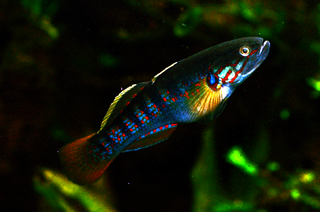 W
WMogurnda mogurnda, commonly known as the northern trout gudgeon or northern purple-spotted gudgeon is a freshwater fish native to northern Australia and New Guinea.
 W
WCraterocephalus marjoriae, commonly known as Marjorie's hardyhead or silverstreak hardyhead, is a species of fish in the family Atherinidae that is native to eastern Australia, namely central Queensland to northeastern New South Wales. Here it inhabits clear flowing streams and it is common among the vegetation in their margins. It prefers shallow water over streambeds consisting of sand or gravel. It forms shoals. They spawn on multiple occasions between September and January, although this peaks earlier in the season. They form pairs for spawning, the eggs being deposited on aquatic vegetation to which they adhere. The eggs are large measuring 1.15-1.25 mm in diameter and have adhesive filaments. The eggs hatch after around a week and the larvae measure about 5.7 mm standard length. Their diet consist mostly of aquatic insects and their larvae, small crustaceans, algae and fish eggs. This species was described by Gilbert P. Whitley in 1948 with the type locality given as Eidsvold on the Burnett River in Queensland. Whitley may have named this species in honour of his sister Marjorie Frewer.
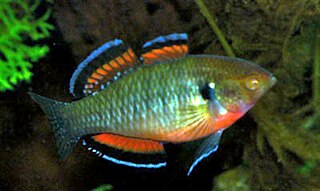 W
WHypseleotris compressa, the empire gudgeon, is a species of Gobiiform fish in the family Eleotridae endemic to Australia and south-central New Guinea.
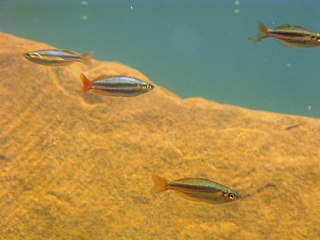 W
WMelanotaenia australis, the western rainbowfish, is a species of freshwater rainbowfish endemic to Australia's Kimberley and Pilbara,, Top End.
 W
WMelanotaenia duboulayi, the crimson-spotted rainbowfish, less commonly known as the Duboulay's rainbowfish, is a species of freshwater rainbowfish endemic to eastern Australia. M. duboulayi has also been kept in aquariums since the early 20th century, and is the original Australian rainbowfish.
 W
WMogurnda adspersa is a species of endangered gudgeon that is endemic to southeastern Australia. The fish is brown, although the shade becomes lighter near its abdomen. Spots of various colors occur on its sides. After a dramatic population decline in the late 20th century, the fish was thought to be extinct, but it was rediscovered in 2002. The government of Australia is currently taking measures to increase the fish's numbers.
 W
WThe mountain galaxias is a species complex of freshwater galaxiid fish found all over southeast Australia.
 W
WNannoperca oxleyana, commonly known as the Oxleyan pygmy perch, is a species of temperate perch endemic to Australia. It occurs in the coastal drainages of eastern Australia, being found in dune lakes, ponds, creeks, and swamps with plentiful vegetation to provide shelter. The waters in which it lives are often dark and acidic. It preys upon aquatic insects and their larvae, as well as planktonic crustaceans and even algae. This species can reach 7.5 cm (3.0 in) SL, though most do not exceed 4 cm (1.6 in). It can also be found in the aquarium trade.
 W
WNeoarius berneyi, the highfin catfish, Berney's catfish, Berney's shark catfish, or the lesser salmon catfish, is a freshwater sea catfish that is commonly kept in aquariums. The origin of the name Neoarius berneyi is Greek, with the genus name Neoarius coming from the words neos meaning new and arios, meaning warlike or hostile, in reference to the well developed fin spines, and the species name, berneyi, comes from the ornithologist F. L. Berney.
 W
WNeoarius graeffei, also known as the blue salmon catfish, salmon catfish, or lesser salmon catfish, is a species of catfish found in freshwater rivers of Australia and Papua New Guinea.
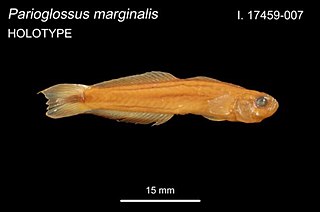 W
WParioglossus marginalis, also known as the blackmargin dartfish, is a species of dartfish native to the brackish waters of the coast of New South Wales, Australia and around the northern part of the North Island and Great Barrier Island in New Zealand, This species may be an introduced species in New Zealand, being brought from Australia in ship's ballast water. This species can reach a length of 3.3 centimetres (1.3 in) SL. It is thought by some workers that Parioglossus neoclaedonicus from New Caledonia may be a synonym of P. marginalis and that the Caroline Islands species Parioglossus verticalis, which is known form just a single specimen, may also be synonymous with this species. To resolve these taxonomic uncertainties molecular studies will be required.
 W
WThe estuary perch is a species of temperate perch endemic to south-eastern Australia, where it prefers brackish waters such as lower tidal reaches of coastal lakes, rivers, and streams.
 W
WThe golden perch is a medium-sized, yellow or gold-coloured Australian freshwater fish species found primarily in the Murray-Darling River system, though a subspecies is found in the Lake Eyre-Cooper Creek system, and another subspecies, suspected to be ancestral to all other populations, is found in the Fitzroy River system in Queensland. Golden perch are not a true perch of the genus Perca, but a member of the Percichthyidae family.
 W
WThe Macquarie perch is an Australian native freshwater fish of the Murray-Darling river system. It is a member of the family Percichthyidae and is closely related to the golden perch.
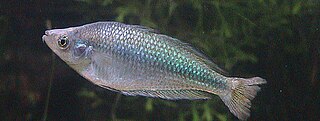 W
WThe Australian rainbowfish, known less commonly as the Murray River rainbowfish or the crimson-spotted rainbowfish, is a species of freshwater rainbowfish endemic to Australia. They are very colourful, hence their name; males of this species are more colourful than females. Australian rainbowfish are schooling fish and will congregate near logs or riverbanks.
 W
WThe banded rainbowfish, also known as the Jewel rainbowfish, Goyder River rainbowfish, three-striped sunfish or regal rainbowfish, is a species of Rainbowfish found in the northerly regions of North Australia and Queensland. an adult Banded Rainbowfish can reach a stranded length of 15 cm -12 cm with a deep body usually exceeding 1/3 of their body length, like most Rainbowfish banded Rainbowfish vary in colour depending on where they were collected, but all variety's have a distinct dark mid-lateral band and bright red/yellow Dorsal, anal, and caudal fins.
 W
WThe threadfin rainbowfish or featherfin rainbowfish is a rainbowfish, the only species in the genus Iriatherina. It is characterized by long beautiful fins, and is among the most attractive of the rainbowfishes.
 W
WScleropages jardinii, the Gulf saratoga, Australian bonytongue or Northern Saratoga, is a freshwater bony fish native to Australia and New Guinea, one of two species of fishes sometimes known as Australian arowana, the other being Scleropages leichardti. It has numerous other common names, including northern saratoga, toga and barramundi. It is a member of the subfamily Osteoglossinae, a (basal) teleost group. Its scientific name is sometimes spelled S. jardini.
 W
WScortum barcoo is a species of fish in the family Terapontidae, known by the common names Barcoo grunter and jade perch. It is endemic to Australia, where it can be found in certain major rivers, including the Barcoo River. It is reared in hatcheries.
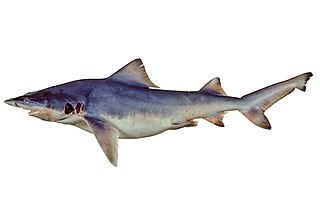 W
WThe northern river shark or New Guinea river shark is a species of requiem shark, in the family Carcharhinidae, found in scattered tidal rivers and associated coastal waters in northern Australia and in Papua New Guinea. This species inhabits areas with poor visibility, soft bottoms, and large tides, with immature sharks ranging into fresh and brackish water. It is similar to other river sharks in having a stocky grey body with a high back, tiny eyes, and broad fins. It measures up to 2.5 m (8.2 ft) long.
 W
WThe speartooth shark is an extremely rare species of river shark, belonging to the family Carcharhinidae. It inhabits coastal marine waters and tidal reaches of large tropical rivers in northern Australia and New Guinea. Despite being a member of the river shark genus, it is also found in near-shore marine waters, favoring highly turbid environments over a wide range of salinities. This robustly built, gray-colored shark is characterized by a short and broad snout, tiny eyes, a relatively large second dorsal fin, and a black blotch beneath each pectoral fin near the tip. Another identifying trait is its teeth, which are large, triangular, and serrated in the upper jaw and narrow, spear-like, and serrated only near the tips in the lower jaw. Adults grow to about 2.6 m (8.5 ft) long.
 W
WThe short-finned eel, also known as the shortfin eel, is one of the 15 species of eel in the family Anguillidae. It is native to the lakes, dams and coastal rivers of south-eastern Australia, New Zealand, and much of the South Pacific, including New Caledonia, Norfolk Island, Lord Howe Island, Tahiti, and Fiji.
 W
WThe Australian smelt is a small, pelagic silvery freshwater fish found in large numbers in waters of the south eastern Australian mainland.
 W
WThe southern pygmy perch, also known as the Tasmanian pygmy perch, is a species of freshwater ray-finned fish, a temperate perch from the family Percichthyidae which is native to southeastern Australia and Tasmania.
 W
WThe speckled longfin eel, Australian long-finned eel or marbled eel is one of 15 species of eel in the family Anguillidae. It has a long snake-like cylindrical body with its dorsal, tail and anal fins joined to form one long fin. It usually has a brownish green or olive green back and sides with small darker spots or blotches all over its body. Its underside is paler. It has a small gill opening on each side of its wide head, with thick lips. It is Australia's largest freshwater eel, and the female usually grows much larger than the male. It is also known as the spotted eel.
 W
WSpotted galaxias is a largish, primarily-freshwater galaxias species found in southern Australia. Spotted galaxias are perhaps the most beautiful of the Australian galaxias species. They are a somewhat tubular, deep-bodied fish, with a dusky brownish-red colouration overlain with dark, haloed spots, dramatic black edges to dorsal, anal and pelvic fins, and a dark diagonal stripe through the eye.